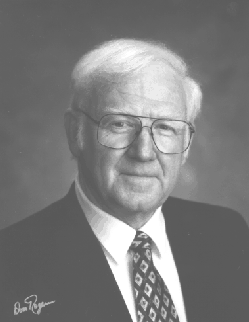
Spring/Summer 1999
Volume 6, Issue 2
Spring/Summer 1998
Volume
3, Issue 1
January 1995
Volume
2, Issue 4
October 1994
Volume
2, Issue 1
January 1994
EAC FOCUS
John D. Ingram
Research Fellow and Senior Technical Staff Member, Schlumberger Limited
John D. Ingram has studied and worked in a variety of scientific disciplines, all of which have contributed to his career-long interest and research in the field of wave propagation and related areas. He received his B.S. in chemistry and M.S. in geophysics at the University of Tulsa and his Ph.D. in engineering sciences at Purdue University. He began his career in 1959 as a senior research engineer at Esso Production Research Company in Houston, where he worked in the area of exploration seismology. In 1965, he joined Rice University's Mathematical Sciences and Mechanical Engineering Departments, where he worked as an assistant professor and later as tenured associate professor while continuing his personal research in wave propagation.
In 1971, Ingram embarked on a career at Schlumberger that would eventually lead him to a variety of high-profile management and research positions around the country and in France. He began as Mechanics Department Head at Schlumberger-Doll in Connecticut, where he directed research in wave propagation and mechanical processes in boreholes. In 1975, Ingram left to spend two years in France at Etudes et Productions Schlumberger as Department Director of Engineering Physics and Electrical Engineering. Ingram returned to the U.S. in 1977 to accept the position of Vice President of Engineering at Schlumberger Well Services in Houston, the company's largest engineering center. He returned to France in 1983 as Vice President of Research and Development for Measurement and Systems for Schlumberger's Measurement and Control Group. In 1987, Ingram became Vice President and Chief Technical Officer at Schlumberger Limited in New York, and since 1992 has been a research fellow and senior technical staff member for the New York and Austin divisions.
Ingram's career accomplishments include developing and applying new software, mathematical simulations, digital sonic systems, and imaging techniques for use in oil and gas exploration and recovery projects. He created the Schlumberger Laboratory for Computer Science in Austin and initiated research in parallel computation that resulted in the commercial products currently running on Connection Machines. He is currently developing hybrid analytical/numerical techniques for the solution of wave propagation problems. The first stage of this work is nearing completion and has produced the first analytical solution to wave propagation in a stratified borehole. According to Ingram, this work shows considerable promise for more complex applications.
Ingram served on the CRPC External Advisory Committee for several years and has been an emeritus member since June 1996. According to Ingram, his role as an advisor to CRPC management also directly benefited his career. "My CRPC relationship has been very significant both to me and to Schlumberger, especially as we plunged into the commercial implementation of parallel processing in seismic processing and interpretation," he says. "The contacts with the outstanding people in the CRPC have been especially valuable and have broadened my perspective considerably."
Ingram is the author of more than 20 research papers and holds 20 patents. He is on the NSF Task Force on the Future of the National SuperComputing Centers and serves as a member of the Advisory Board at the School of Computer Science, Carnegie-Mellon University, and the External Advisory Board at the School of Earth and Planetary Sciences at Caltech.
